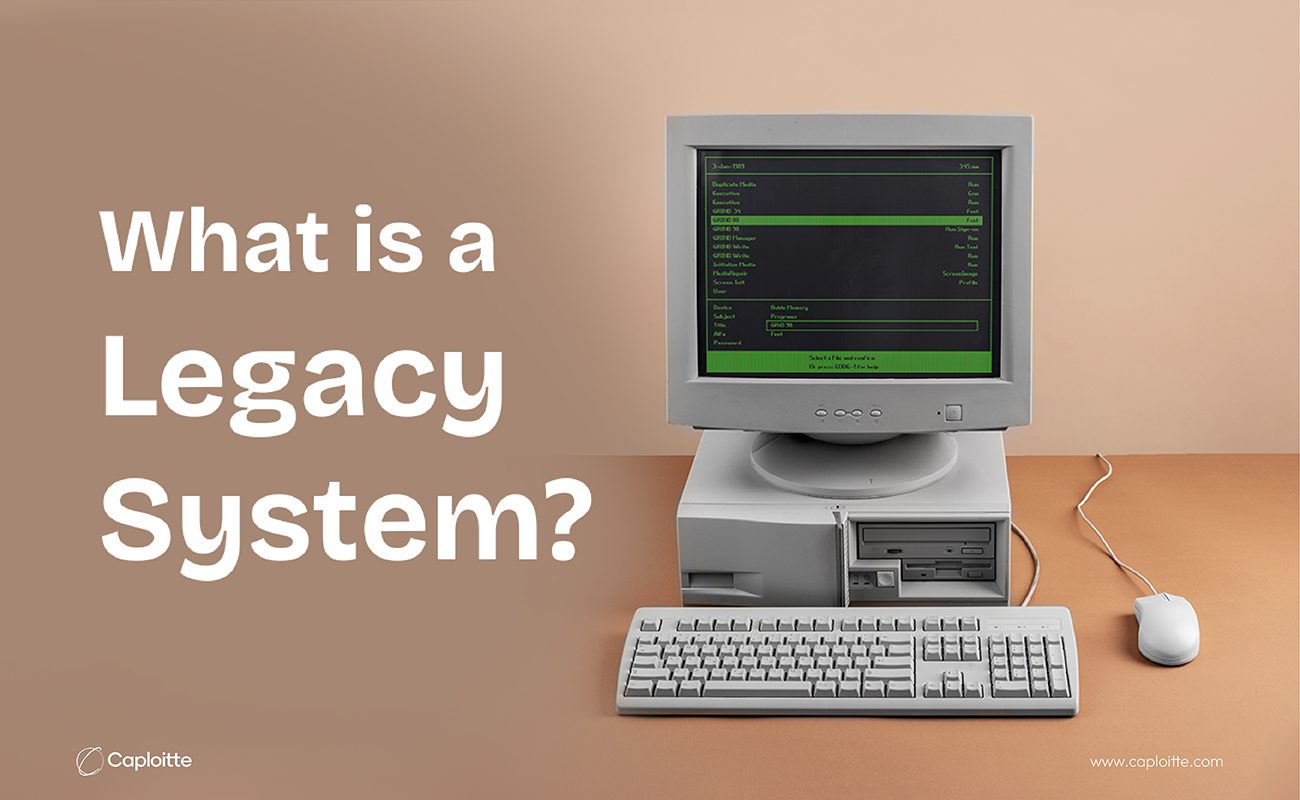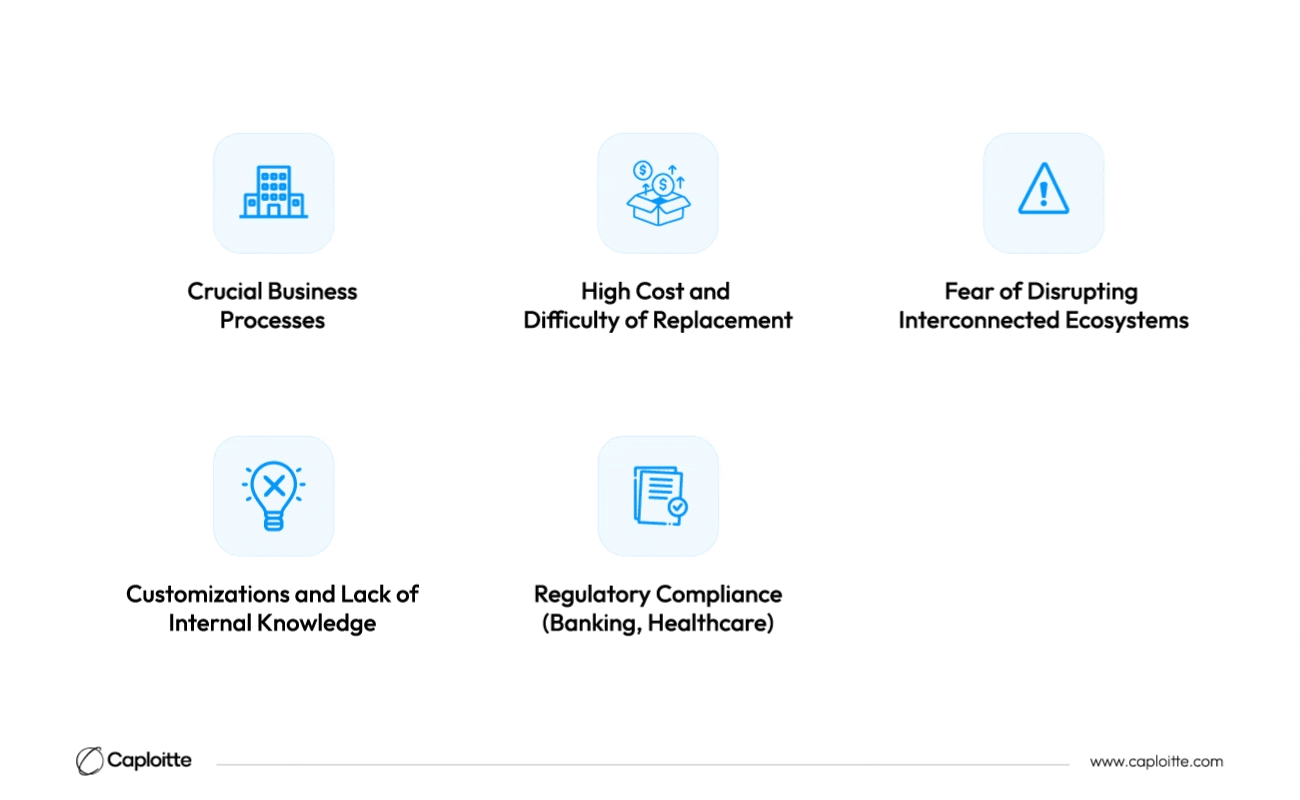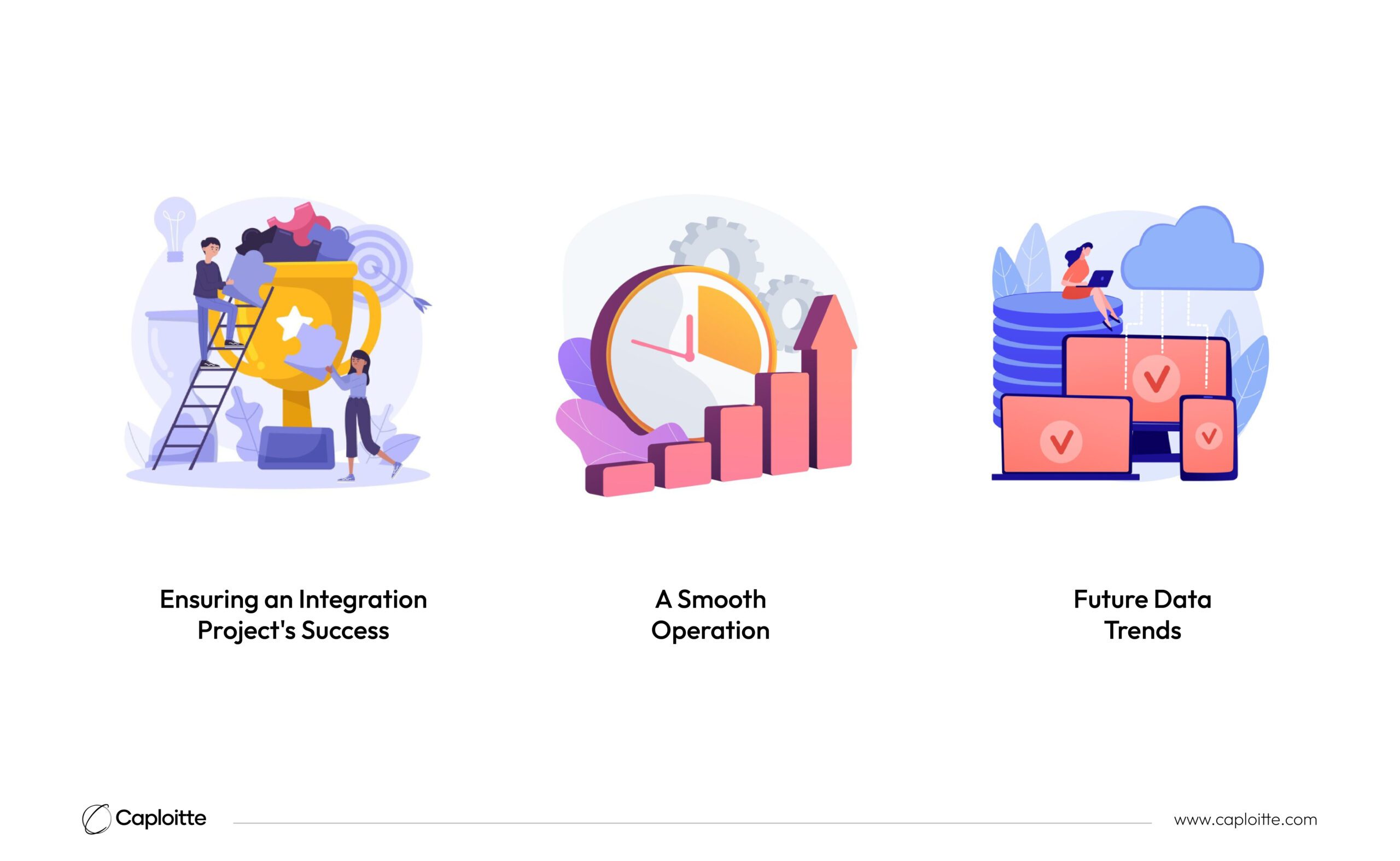Legacy Systems vs. Custom Solutions: Modernizing Your Technology Stack
-
Caploitte
-
30 July 2024
-
03 Min Read
What is a Legacy System?
Why are Legacy Systems still used?
The Long-Lasting Legacy Systems
Retain or Retire Legacy Systems
Re-platform Legacy Systems
Issues with Outdated Architectures and Systems
Languages for Programming Retired
What are Custom Solutions?
How does Custom Software Development play in resolving these issues?
Upgrades to Systems
Benefits of custom solutions in enhancing legacy system
Conclusion
What is a Legacy System?

A legacy system is a platform, application, or technology that once was on the cutting edge but is now outdated. It can be regarded as outdated if it needs a lot of maintenance to be compatible with newer systems or if a more modern version has replaced it. Legacy software, typically older than one decade, can be defined by its inability to handle the tasks required by the organization adeptly. If the cost to keep software running has become prohibitive, it’s also a sign of disadvantageous business operation. So, what does “legacy” mean in software? A system’s status as a “legacy” varies according to certain business goals. The state of technology at the time of implementation also identifies the system as outdated.
Why are Legacy Systems Still Used?

The persistence of legacy systems may be attributed to several causes, including their crucial involvement in crucial business processes and their high cost and difficulty of replacement. Customizations and a deficiency of internal knowledge also play a role in the resistance to updating. Businesses like banking and healthcare that are subject to strict rules could be resistant to change in order to stay compliant. The sense of stability in current systems, risk aversion, and interoperability issues all contribute to their prolonged usage. Other considerations affecting the decision to continue with legacy systems include long life cycles, gradual modernization, and the fear of upsetting interconnected ecosystems.
The Long-Lasting Legacy Systems
Legacy systems, which are technology, software, and processes that are inherited from previous stages of business, have represented the backbone of companies for (many) years. Nowadays, however, these systems have started to hinder business goals since they precede modern integration standards, cannot catch up with the latest technologies, and are mostly outdated.
There are typically two situations that we’ve noticed. Either older systems can slow down operations, no longer meet the demands of the business, or present integration challenges when paired with newly implemented systems, or legacy systems can still handle ongoing workloads and may only require occasional maintenance or adjustments.
Therefore, even while legacy systems may still be able to accomplish most of the tasks for which they were intended, they may not support expansion or communication with more modern technology. Legacy applications are information systems that are essential to daily operations even if they may be built on outdated technology. Many creative companies have expanded thanks to these legacy systems. Companies may decide to keep using legacy systems for a variety of reasons, such as economic considerations, apprehension about making major changes to the system, or just the challenge of updating. However, it is always advised to upgrade your systems because it can accommodate various adjustments to your company plan and is more cost-effective in the long run.
Retain or Retire legacy systems?
With guidance from a reliable legacy system modernization team, a business may decide between these two options: keeping the old system in place or retiring it entirely. If it is decided to keep the old system, at the very least, a strategy for optimizing its most important features should be in place. This is particularly crucial if there are legacy components that are non-compliant, hazardous, insecure, or inefficient. It is nevertheless necessary to address these concerns even in the absence of a modernization strategy.
When it comes to retiring, it is usually decided to stop using the outdated systems and move all users on to more modern ones. To compensate for the loss of the legacy system, this might entail making changes to those other systems. However, compared to a complete rebuild or replacement, the amount of work required will be far less.
Re-platform legacy systems

Replatforming is the process of moving the existing legacy system components to a new runtime platform. A runtime platform is a framework that allows an application’s conception, development, and modification by a team of software engineers. With little to no modifications to the current code, features, and functions, new features and enhancements can be added by moving to a different runtime platform. Transferring a program from a UNIX system to a Windows or Linux environment is an example of re-platforming.
1. Outdated Technology:
When your technology is out of step with current advancements, you can be certain that you are running an outdated system. This results in decreased functionality, poor performance, and an inability to meet client needs.
2. High Maintenance Expenses:
Is the IT budget you spend going more toward keeping outdated software running smoothly than toward adding value to the company? Because of the lack of component availability, the difficulty in finding skilled personnel, and the ongoing need for patches and upgrades to avert privacy and security breaches as well as system failures, legacy software frequently has significant maintenance costs.
3. Inadequate Work:
Your outdated system reduces productivity if it crashes frequently, needs to be rebooted frequently, or slows down a lot when used regularly.
4. Inadequate Integration and Scalability:
Is your company expanding its operations or trying to grow? The inflexibility of a legacy system might be a major barrier to expanding your business or combining it with contemporary apps.
5. Risks Associated with Compliance:
For any organization, maintaining compliance with industry and data rules is an unavoidable obligation. However outdated systems sometimes don’t have the capabilities or upgrades needed to meet the most recent compliance standards, which puts your company at unneeded risk.
6. User Dissatisfaction:
Which would an employee prefer—using their own devices or a slow, complex system that necessitates many steps to do a task? Anger from users may be a red flag for more serious performance problems.
7. Inefficiencies in Business:
Inefficiencies and bottlenecks in your business operations might be caused by old systems. This might be due to poor workflow assistance, an excessive dependence on human data entry, or outmoded reporting tools.
Here’s where some low-code automation capabilities might come in handy and easily improve your present functionalities.
Issues with Outdated Architectures and Systems
The primary problems that most businesses have with their legacy systems are that they don’t align with the aims or business processes of the present, that there aren’t enough experts to manage them, and that there aren’t many viable solutions for various connections.
Languages for Programming Retired
Legacy systems are often developed in programming languages like FORTRAN, assembly, BASIC, and COBOL, to mention a few, and are built so long ago that even the developers who designed them may have since retired.
In these situations, organizations are faced with the decision of whether to keep or retire their legacy systems since new personnel are unaware of what is included in the Spaghetti code, or legacy systems code. However, outdated programming languages are not the only problem you might face. Key features of legacy systems are absent, they can malfunction, pose security threats, and be challenging to update or integrate with more modern technology.
What are Custom Solutions?

Custom solutions refer to tailor-made or bespoke products, services, or systems that are specifically designed to meet the unique needs and requirements of a particular individual, organization, or situation. These solutions are developed from scratch or customized from existing frameworks, platforms, or technologies to address specific challenges or opportunities faced by the client. Custom solutions can span various domains, including software development, hardware design, consulting services, and more. They often involve close collaboration between the client and solution provider to understand the exact requirements, preferences, and constraints, ensuring that the final product or service is precisely aligned with the client’s goals and objectives.
How does Custom Software Development play in resolving these issues?
Digital products as well as specialized software to support enterprises’ expansion and innovation are created at customer software development. For organizations, digital transformation is an effective tool that is necessary for distinguishing, growing, and inventing. By transferring outdated systems to current platforms and technologies, custom software provides a route toward modernization. Custom software development optimizes scalability, efficiency, and usability by various means such as re-architecting apps, streamlining codebases, or improving user interfaces.
Furthermore, specialized software allows for smooth integration with contemporary apps and outside services by bridging the gap between the old and the new. This increases company agility by promoting data interchange, automating operations, and dismantling internal barriers. Custom solutions, which are built to scale, change with the business to accommodate expansion and shifting needs without being constrained by existing systems.
Upgrades to Systems

To remain competitive, modern organizations must swiftly implement new features. The systems cannot expand at the same rate as the company if they are outdated and unable to be expanded. Additionally, the ability to add new functions is limited by the sets of APIs that are the foundation of most old legacy systems. Furthermore, point-to-point integration—that is, using specially written code to link two applications—is insufficient if several integrations need to be completed.
Those outdated systems typically cannot manage the ease with which new technologies, partners, and services may be integrated, or the large-scale cloud-based initiatives related to big data, AI, ML, and IoT. If the legacy systems are too old, you will have to either recreate the functionality from scratch or construct a customized integration, which is not future-proof, every time you need to add a new data set, feature, or integration. A platform for cloud-based integration can assist in integrating contemporary apps with outdated systems.
1). Ensuring an Integration Project’s Success
Before beginning the project, it’s critical to carefully evaluate the demands of your company and the specifications for the product. Making sure the software you select is beneficial in the long run and increasing the chances of project success may be achieved by conducting a comprehensive audit and study of the present solutions.
2). A Smooth Operation
Software ought to support you rather than hinder you. Custom software solutions are made to increase efficiency, get rid of latency in the system, and enhance responsiveness. They accomplish this by regularly optimizing the system, utilizing contemporary technology, and writing efficient code. As a consequence, system downtime is significantly reduced, preserving the productivity and competitiveness of your company. You may get better business outcomes and more seamless operations by using software that operates at peak efficiency.
3). Future Data Trends
In this age of rapid change, analyzing historical data is no longer sufficient. For good reason, the majority of businesses now analyze data in real time. This allows them to quickly act on insights gathered in real-time, adapt quickly to changing business goals and environments, and maintain a competitive edge.
Benefits of custom solutions in enhancing legacy system:

There are a few important things to remember while using custom software to improve outdated systems:
1). More flexibility and control over your systems are provided by custom software development, which provides one-of-a-kind solutions catered to your company’s demands.
2). You may prolong the life of your legacy systems and avoid the hefty expenses involved in replacing them completely by investing in bespoke software.
3). To make sure that your systems are compatible with new developments in technology and market trends, custom solutions can assist in future-proofing them.
Disadvantages:
There are a few disadvantages of the custom system as well which are discussed below:
1). Failures might range from genuine crashes and system outages to inefficient operation or even outdated systems that are unable to handle increased demands. All of these can be expensive for your company and serve merely to stifle advancement and creativity. The expenses incurred for fixing the systems as well as the expenditures incurred when your employees are unable to perform their duties as intended because of downtime, such as when a new product is delayed.
2). Significant cybersecurity risks associated with custom solutions might include hacking, identity theft, data breaches, distributed denial-of-service (DDoS) assaults, malicious attacks, and, in more recent times, cryptocurrency mining.
Conclusion
In addition to real assaults on your systems, some outdated hardware or software services may no longer be supported by the original suppliers; out-of-market hardware and no updates indicate inadequate protection for the most recent vulnerabilities, increasing the risk of attack on your entire system.
Share this post:
Read More
- All
- AI
- AR
- DevOps and CI/CD
- E-commerce
- FinTech
- IoT
- Mobile Development
- Outstaffing
- Security
- SEO
- Tech Trends
- Web Design
- Web Development




